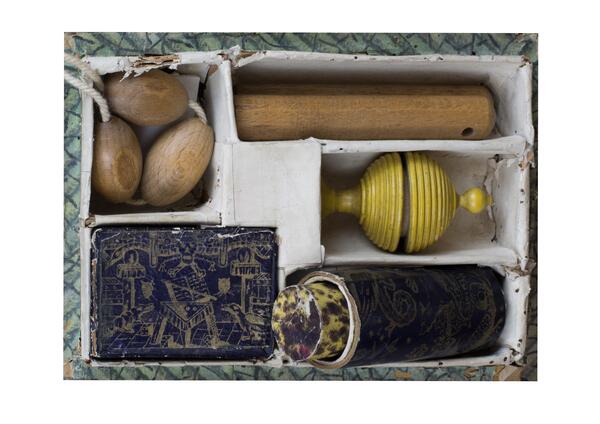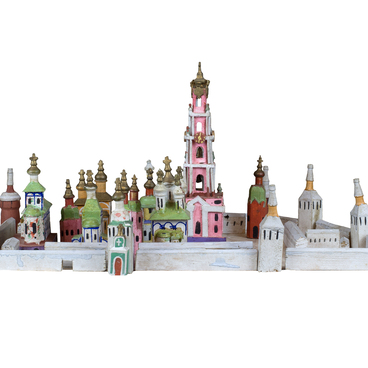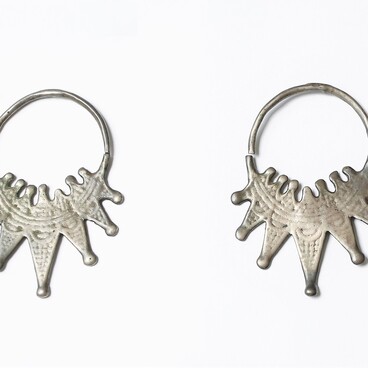The art of tricks, or illusionism, appeared in ancient times. The fakirs were the first to show magic tricks. They were Indian wandering monks who practiced yoga, charmed diseases away, trained animals. Initially, these actions were indued with religious and magical characteristics but gradually acquired an entertainment character.
In the Middle Ages, professional artists appeared at fairs — puppeteers and magicians, who used various mechanisms that create optical illusions. At the same time, card tricks appeared, based on the sleight of hand of the person who showed them.
Over time, magic tricks became more complicated. For example, artists learned to “transform” some objects into others. And the shell game artists, independently or with the help of assistants, distracted the audience’s attention with repetitive movements and invisibly moved objects under the thimbles.
A toy set for children’s magic tricks in a cardboard box entered the museum in 2000. It was donated by a local collector of antiques Sergey Korolev.
The cardboard box contains small playing cards, a cardboard spyglass, strings with wooden beads at the ends, and a two-piece wooden object.
Cards and strings were for simple magic tricks of appearing, disappearing, and substituting objects. And the purpose of the wooden toy is not certain. Its lower part is made in the form of a shot glass, and the upper part is a whipping-top. Experts suspect that it was used for a magic trick called the “ball in a shot glass”. During this trick, the magician shows the audience a glass and the ball inside it. Then he takes out the ball and puts it in his pocket, and covers the empty glass with a cap. After that, he makes magical movements, opens the glass and shows the ball, which is again inside it. This magic trick is based on sleight of hand. The illusionist does not actually put the ball in his pocket but hides it in his hand or sleeve. Making passes with his palms, he, unnoticed by the audience, puts it back into the glass.
A cardboard spyglass is used for similar magic tricks. The illusionist shows that it is transparent and there is nothing in it. Then, he pronounces a spell, after which he takes out various objects from the pipe: scarves, balls, candies. In such a pipe, there is usually a special hidden section where the magician hides objects in advance.
In the Middle Ages, professional artists appeared at fairs — puppeteers and magicians, who used various mechanisms that create optical illusions. At the same time, card tricks appeared, based on the sleight of hand of the person who showed them.
Over time, magic tricks became more complicated. For example, artists learned to “transform” some objects into others. And the shell game artists, independently or with the help of assistants, distracted the audience’s attention with repetitive movements and invisibly moved objects under the thimbles.
A toy set for children’s magic tricks in a cardboard box entered the museum in 2000. It was donated by a local collector of antiques Sergey Korolev.
The cardboard box contains small playing cards, a cardboard spyglass, strings with wooden beads at the ends, and a two-piece wooden object.
Cards and strings were for simple magic tricks of appearing, disappearing, and substituting objects. And the purpose of the wooden toy is not certain. Its lower part is made in the form of a shot glass, and the upper part is a whipping-top. Experts suspect that it was used for a magic trick called the “ball in a shot glass”. During this trick, the magician shows the audience a glass and the ball inside it. Then he takes out the ball and puts it in his pocket, and covers the empty glass with a cap. After that, he makes magical movements, opens the glass and shows the ball, which is again inside it. This magic trick is based on sleight of hand. The illusionist does not actually put the ball in his pocket but hides it in his hand or sleeve. Making passes with his palms, he, unnoticed by the audience, puts it back into the glass.
A cardboard spyglass is used for similar magic tricks. The illusionist shows that it is transparent and there is nothing in it. Then, he pronounces a spell, after which he takes out various objects from the pipe: scarves, balls, candies. In such a pipe, there is usually a special hidden section where the magician hides objects in advance.



